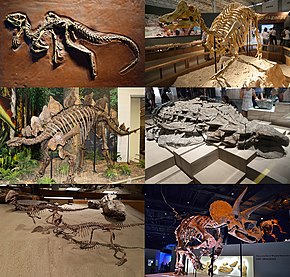| Ornithischia | |
|---|---|

| |
| A collection of ornithischian fossil skeletons. Clockwise from upper left: Heterodontosaurus (Heterodontosauridae), Nipponosaurus (Ornithopoda), Borealopelta (Ankylosauria), Triceratops (Ceratopsia), Stegoceras (Pachycephalosauria), and Stegosaurus (Stegosauria). | |
| Scientific classification | |
| Domain: | Eukaryota |
| Kingdom: | Animalia |
| Phylum: | Chordata |
| Clade: | Dinosauria |
| Clade: | †Ornithischia Seeley, 1888[1] |
| Subgroups[5] | |
| |
| Synonyms | |
Ornithischia (/ˌɔːrnəˈθɪski.ə/) is an extinct clade of mainly herbivorous dinosaurs characterized by a pelvic structure superficially similar to that of birds.[6] The name Ornithischia, or "bird-hipped", reflects this similarity and is derived from the Greek stem ornith- (ὀρνιθ-), meaning "bird", and ischion (ἴσχιον),[a] meaning "hip".[7] However, birds are only distantly related to this group, as birds are theropod dinosaurs.[6]
Ornithischians with well known anatomical adaptations include the ceratopsians or "horn-faced" dinosaurs (e.g. Triceratops), the pachycephalosaurs or "thick-headed" dinosaurs, the armored dinosaurs (Thyreophora) such as stegosaurs and ankylosaurs, and the ornithopods.[6] There is strong evidence that certain groups of ornithischians lived in herds,[6][8] often segregated by age group, with juveniles forming their own flocks separate from adults.[9] Some were at least partially covered in filamentous (hair- or feather- like) pelts, and there is much debate over whether these filaments found in specimens of Tianyulong, Psittacosaurus,[10] and Kulindadromeus may have been primitive feathers.[11]
- ^ Cite error: The named reference
seeley88was invoked but never defined (see the help page). - ^ a b Cite error: The named reference
normanea22was invoked but never defined (see the help page). - ^ Cite error: The named reference
madziaea21was invoked but never defined (see the help page). - ^ Cite error: The named reference
sereno86was invoked but never defined (see the help page). - ^ Fonseca, A.O.; Reid, I.J.; Venner, A.; Duncan, R.J.; Garcia, M.S.; Müller, R.T. (2024). "A comprehensive phylogenetic analysis on early ornithischian evolution". Journal of Systematic Palaeontology. 22 (1): 2346577. doi:10.1080/14772019.2024.2346577.
- ^ a b c d Fastovsky, David E.; Weishampel, David B. (2012). Dinosaurs: A Concise Natural History. Cambridge: Cambridge University Press. ISBN 978-1107276468.
- ^ Colbert, Edwin H. (Edwin Harris); Knight, Charles Robert (1951). The dinosaur book: the ruling reptiles and their relatives. New York: McGraw-Hill. p. 152.
- ^ Qi, Zhao; Barrett, Paul M.; Eberth, David A. (2007-09-01). "Social Behaviour and Mass Mortality in the Basal Ceratopsian Dinosaur Psittacosaurus (early Cretaceous, People's Republic of China)" (PDF). Palaeontology. 50 (5): 1023–1029. Bibcode:2007Palgy..50.1023Q. doi:10.1111/j.1475-4983.2007.00709.x. ISSN 1475-4983. S2CID 128781816.
- ^ Zhao, Q. (2013). "Juvenile-only clusters and behaviour of the Early Cretaceous dinosaur Psittacosaurus". Acta Palaeontologica Polonica. doi:10.4202/app.2012.0128.
- ^ Mayr, Gerald; Peters, Stefan D.; Plodowski, Gerhard; Vogel, Olaf (2002-08-01). "Bristle-like integumentary structures at the tail of the horned dinosaur Psittacosaurus". Naturwissenschaften. 89 (8): 361–365. Bibcode:2002NW.....89..361M. doi:10.1007/s00114-002-0339-6. ISSN 0028-1042. PMID 12435037. S2CID 17781405.
- ^ Godefroit, P.; Sinitsa, S.M.; Dhouailly, D.; Bolotsky, Y.L.; Sizov, A.V.; McNamara, M.E.; Benton, M.J.; Spagna, P. (2014). "A Jurassic ornithischian dinosaur from Siberia with both feathers and scales" (PDF). Science. 345 (6195): 451–455. Bibcode:2014Sci...345..451G. doi:10.1126/science.1253351. hdl:1983/a7ae6dfb-55bf-4ca4-bd8b-a5ea5f323103. PMID 25061209. S2CID 206556907. Archived from the original (PDF) on 2019-02-09. Retrieved 2016-08-28.
Cite error: There are <ref group=lower-alpha> tags or {{efn}} templates on this page, but the references will not show without a {{reflist|group=lower-alpha}} template or {{notelist}} template (see the help page).